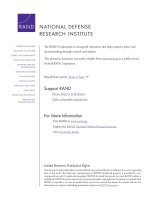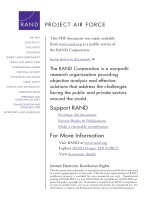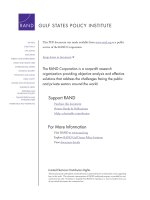5 13 after the attack
Bạn đang xem bản rút gọn của tài liệu. Xem và tải ngay bản đầy đủ của tài liệu tại đây (4.6 MB, 10 trang )
Fascinating Facts
• The Pentagon is actually made up of five buildings that fit
snugly together. There are fifteen hallways that connect
the buildings of the Pentagon.
• The collapsed steel and concrete from the World Trade
Center buildings weighed 1.8 million tons and filled
108,342 trucks.
• When the waiting lines for New York’s ferries became too
long on September 11, 2001, people from New York and
New Jersey who owned private boats began sailing back
and forth. These extra boats helped get people across the
water and closer to their homes.
Genre
Nonfiction
Comprehension Skill
Summarize
Text Features
• Captions
• Headings
Scott Foresman Social Studies
ISBN 0-328-14920-9
ì<(sk$m)=bejcaj< +^-Ä-U-Ä-U
by Barbara Fifer
On September 11, 2001, terrorists hijacked airplanes and
crashed them into the Twin Towers in New York City and
into the Pentagon. Thousands of people were killed and
injured in those attacks. In this book you will read about
how the heroic efforts of ordinary people along with those
of rescue workers helped the injured after the attacks.
Vocabulary
terrorist
Write to It!
Research someone in your community who made a
difference or a historic event that took place in your
community. Write two or three paragraphs describing
why that person or event should be remembered and
honored with a memorial.
Write your ideas on a separate sheet of paper.
hijack
pentagon
headquarters
memorial
Photographs
Every effort has been made to secure permission and provide appropriate credit for photographic material. The publisher deeply
regrets any omission and pledges to correct errors called to its attention in subsequent editions.
Unless otherwise acknowledged, all photographs are the property of Scott Foresman, a division of Pearson Education.
Photo locators denoted as follows: Top (T), Center (C), Bottom (B), Left (L), Right (R), Background (Bkgd)
Opener; ©Susie Walsh/AFP/Getty Images
2 ©Jim Zuckerman/Corbis
3 ©Kelly-Mooney Photography/Corbis
4 ©Corbis
5 ©Wilhelm Scholz/Getty Images
6 ©Catherine Leuthold/Corbis
7 ©Getty Images
8 ©Susie Walsh/AFP/Getty Images
9 ©Chad Slattery/Getty Images
10 ©AP/Wide World Photos
Editorial Offices: Glenview, Illinois • Parsippany, New Jersey • New York, New York
11 ©AP/Wide World Photos
12 ©Reyes Damaso/Gamma
Press,
Inc. Needham, Massachusetts • Duluth, Georgia • Glenview, Illinois
Sales
Offices:
13 ©Bernd Obermann/Corbis
Coppell, Texas • Sacramento, California • Mesa, Arizona
14 ©Tannenbaum Allan/Gamma Press, Inc.
15 ©Archimation/Studio Daniel Liebeskind
by Barbara Fifer
ISBN: 0-328-14920-9
Copyright © Pearson Education, Inc.
All Rights Reserved. Printed in the United States of America. This publication is protected
by Copyright, and permission should be obtained from the publisher prior to any prohibited
reproduction, storage in a retrieval system, or transmission in any form by any means,
electronic, mechanical, photocopying, recording, or likewise. For information regarding
permission(s), write to: Permissions Department, Scott Foresman, 1900 East Lake Avenue,
Glenview, Illinois 60025.
1 2 3 4 5 6 7 8 9 10 V0G1 14 13 12 11 10 09 08 07 06 05
“Twin Towers” and More
Thousands of people were working in the World Trade Center
in New York on the morning of September 11, 2001.
Terrorist Attacks
September 11, 2001, began as a clear autumn morning in
the northeastern United States. People were still arriving at work
when an airplane crashed into one of the World Trade Center’s
Twin Towers in New York City. Many people at first thought it
was a horrible accident, but eighteen minutes later another plane
crashed into the second tower. Thirty-seven minutes after that, a
third airliner crashed into the Pentagon in Arlington, Virginia,
near Washington, D.C.
Terrorists had overpowered the crews of four airplanes that
morning. The terrorists flew three planes into the buildings on
purpose because they were angry at the United States and its
influence on the world. Passengers on the fourth plane, Flight
93, fought the terrorists and their plane crashed in a field in
Pennsylvania instead of into a crowded building.
These were the first foreign attacks on the United States since
the War of 1812, when Britain had invaded the United States.
Many people became heroes that day. In this book each person’s
story represents many others who did similar things.
2
Seven buildings around an open space called a plaza made
up the World Trade Center. Those buildings stood in New York
City near the southern end of Manhattan Island.
Businesses rented space in six of the buildings for their
offices, with some large companies occupying more than one
floor. About 50,000 people worked in the offices. The seventh
building was a hotel.
When the attacks occurred, at least forty thousand people were
working in the buildings. During a typical workday, about 50,000
people worked there and about 200,000 visitors might pass through
the World Trade Center.
The two most famous buildings were known by several names:
the Twin Towers, North Tower and South Tower, or WTC1 and
WTC2. Both were 110 stories, or 1,368 feet high, and ranked
among the world’s six tallest buildings. Each tower had ninety-seven
elevators for people and six elevators for freight. The North Tower
was completed in 1970, followed by its twin two years later.
Here is a view of the World Trade Center buildings
before the attack.
3
Four Airliners
This is a view of the Pentagon, which is so large that the
United States Capitol could fit into one of its five sides.
A Building Named for Its Shape
Pentagon is the name given to a five-sided figure. The United
States Department of Defense has its home in a building of that
shape, which is simply called “the Pentagon.” It opened in 1943
and is just across the Potomac River from Washington, D.C.
The Pentagon is five stories tall and covers twenty-nine acres.
The total length of its halls is seventeen-and-a-half miles.
The Pentagon is the headquarters, or main office, of all
branches of the United States military. Working in it are about
twenty-three thousand soldiers and civilians, along with about
three thousand support staff.
4
Around eight o’clock on the morning of September 11, 2001,
four airplanes took off with terrorists on board who were pretending
to be regular passengers.
The terrorists hijacked, or took over by force, Flight 11 from Boston,
Massachusetts, and crashed it into the World Trade Center’s North
Tower about an hour later. Shortly after, the same thing happened to
Flight 175, also from Boston, which crashed into the South Tower.
A third plane, Flight 77, left Washington, D.C., and flew as
far as Kentucky before terrorists hijacked it. The terrorists turned it
back toward Washington, D.C., and crashed the plane into one
side of the Pentagon.
A fourth plane, Flight 93, flew from Newark, New Jersey, to
the skies above Ohio. A few people on board heard about the
first three crashes on their cell
phones. When terrorists captured
their plane, some passengers
decided to fight back. A flight
attendant filled two pitchers
with boiling water and several
passengers tried to break into the
cockpit. The terrorists managed
to crash the plane in a field in
northeastern Pennsylvania. Many
people think their real target was
the White House or the United
States Capitol.
Terrorists crashed an airplane into
each of the World Trade Center’s
Twin Towers on September 11, 2001.
Firefighters, Police, and EMTs
After the attacks on the World Trade Center occurred, cement dust
and burning jet fuel filled the buildings with thick, black smoke. Many
people helped one another to escape the buildings.
Michael Benfante and John Cerqueira worked on the eightyfirst floor of the North Tower. They felt the building sway from the
crash and saw fire outside the windows. They began descending
the stairs, knowing that it was not safe to use the elevators.
On the sixty-eighth floor, they met a woman in a wheelchair. Using
a special rescue chair they found, the two men carried her the rest of
the way down the stairs. It took an hour for them to reach safety.
In the South Tower, Welles Crowther used his training as a
volunteer firefighter. He carried some people down the stairs and
got dazed people to help others who had been injured by the
plane crash. Crowther was working alongside New York City
firefighters when the building collapsed.
Other survivors in both towers rescued people trapped under
furniture or walls. When people fainted on the stairs, others
carried them. Some people formed human chains to help one
another over cement slabs that blocked the way.
As office workers made their way down the stairs in the Twin
Towers, firefighters and emergency medical technicians (EMTs)
rushed up the stairs. Each New York Fire Department member
carried sixty pounds of tools along with an oxygen tank.
Outside, other firefighters gathered. They could not reach the fires
high in the towers, but they fought smaller fires on the ground. EMTs
treated injured people as soon as they stumbled outdoors.
The two airplanes each carried about twenty-four thousand
gallons of jet fuel. The fires
created by the crashes burned
as hot as 460 degrees and
weakened the towers’ steel
frames. Soon, the frames
could no longer hold up the
heavy concrete. The towers
had remained standing after
the crashes—the North Tower
for about one hundred minutes,
and the South Tower for nearly
sixty minutes. Thousands of
people escaped during
that time.
Finally, the towers’ steel
frames gave way and the
buildings “pancaked” down,
one floor landing on top of
another. Inside the towers,
343 firefighters and 23 police
officers were killed. Later that
The New York Fire Department crews
day, WTC (Building) 7 and the arrived at the Twin Towers and began
hotel also collapsed.
rescuing people within minutes.
6
7
Even though they were worried about their own safety, many Twin
Towers workers helped others descend the stairs and get outside.
Office Workers Help Each Other
Pentagon Rescuers
The Pentagon has its own police and fire departments, but
many other fire departments from Virginia and the District of
Columbia also came to help.
Many soldiers who worked in the Pentagon quickly created
teams to dig tunnels under furniture and fallen walls, letting
people crawl out. One large man from the Navy held up a ceiling
while people escaped. No one found out his name.
Army Lieutenant Colonel Victor Correa walked through smoke
in a darkened hallway, shouting. Over and over, he yelled, “Listen
to me! Follow my voice!” It worked, and he led people outdoors.
People remembered him as “the man with the big voice.”
Staff Sergeant Christopher Braman, a cook in the Marine Corps,
used his search-and-rescue training when he heard a woman
clapping loudly. She could not breathe well enough to call for
help, and was badly burned. Braman found her and carried her
outside, then went back inside to find others.
Fire departments from around the area came to help the
Pentagon’s own firefighters.
Air traffic controllers watch
images of airplanes on
computers while they talk
with the pilots by radio.
Land the Airplanes!
The Federal Aviation Administration (FAA) sets the rules for
airliners and other non-military airplanes. After the first two
crashes took place on September 11, the FAA stopped planes
from taking off. The FAA also told air traffic controllers to land all
planes at the nearest airports.
Air traffic controllers are the people who talk to pilots by radio,
guiding them while they take off and land at airports. Air traffic
controllers have to be calm in emergencies, such as storms, when
pilots need extra help. Now they had to land nearly four thousand
planes at once—all over the United States!
Only military planes were allowed to fly, including Air Force
One, the President’s plane. President George W. Bush had been
visiting a school in Florida when the attacks occurred.
No one knew if terrorists had already hijacked more airplanes.
If a plane refused to land, it would be checked further.
By about noon, all airliners had landed safely. Only military
planes were allowed to fly for the next two days. Airports made
stranded passengers as comfortable as they could.
9
Searching for Survivors
When the Twin Towers fell, they sent a thick, dark cloud of
smoke and dust through parts of New York City.
Local Businesses Help
When the Twin Towers collapsed in New York City, they filled
the air for many blocks with choking smoke and dust. At that time,
thousands of people were walking and running to safety.
Restaurants, stores, and hotels opened their doors. Managers
let people come inside, have a drink of water, and use the
restrooms. Those services are usually just for customers, but
September 11 was different.
Subways and trains stopped running because no one knew if
they were safe. People had to walk for miles to get home. Some
stores passed out free running shoes to people who had lost theirs
rushing down the stairways or along sidewalks.
A fancy hotel set up beds and cots in its ballroom. Hotel
workers volunteered to stay and help. The chef started cooking
huge batches of food instead of his usual fine dinners. Rescue
workers were welcome to eat and rest at the hotel.
When darkness fell, some people were still stuck on the streets.
Hotels lent them pillows, sheets, and blankets to use during the
cool autumn night.
10
While people were still escaping on buses and ferries to other
parts of New York, rescue workers began digging for survivors at
the Twin Towers.
In New York City and at the Pentagon, off-duty police and
firefighters arrived from everywhere, along with doctors, nurses,
and EMTs. Construction workers brought heavy machines to move
the rubble. The first rescue workers to arrive were local, but more
and more rescuers came from all around the nation.
Trained search-and-rescue dogs came with their owners—about
350 teams in all. The dogs crawled into small spaces, walked on
broken glass, sniffed for survivors, and heard sounds that humans
could not.
Spotlights were set up, and rescuers worked around the clock.
They found a few survivors. Whenever a person was found alive,
rescuers called for silence. All noise stopped until they could
locate the trapped person.
Rescue workers searched for trapped survivors at the Twin Towers
all through the night of September 11, 2001.
People Donate
Within four days, more than 250,000 people donated blood
for Twin Towers’ and Pentagon survivors. Usually, in four days,
only about 91,000 people donate blood. People who are badly
burned or lose blood in accidents need new blood to replace their
lost blood and to help them heal.
In New York City, Robin Merendino, her sisters, their mother,
and a friend, went to forty restaurants and supermarkets to ask for
free hot food for the rescue crews. Soon they had 1,500 pounds
of meals! They needed five vans to deliver the food.
The Nation Gives
Companies around the United States began sending the
products they make. Toys, clothing, blankets, snacks, and other
items began arriving in New York City and Arlington, Virginia.
They were for survivors, families of those who died, and
rescue workers.
Individual citizens, companies, and other groups donated
many items to survivors and rescuers.
Thousands of people donated blood to help those injured in the attacks.
The New York Fire Department lost ninety-one fire trucks, rescue
trucks, and cars when the Twin Towers collapsed and crushed
them. Residents of cities in Louisiana, Ohio, and Utah bought new
fire trucks for the department. Schoolchildren in Columbia, South
Carolina, held a fundraising drive that raised money to buy New
York City a new fire truck. At least two other trucks were gifts from
companies that build fire trucks.
Schools, clubs, and businesses across the United States held
events to raise money. They sent checks to bank accounts that had
been created for those harmed by the attacks. Some accounts were
reserved for educating children who lost relatives, others helped
people who had to move out of damaged apartments, and still
others were for survivors who needed long-term medical care.
12
13
Worldwide Sympathy and Changes
Other nations around the world expressed their sympathy for
the United States’ losses. “Today we are all Americans,” said
Benjamin Netanyahu (bean-yuh-MEAN neh-tuh-NYAH-hoo), a
former prime minister of Israel. He meant that all nations shared in
the sadness of the United States.
Working day and night, people cleaned up the World Trade
Center site and trucked away the broken steel and cement. They
completed the difficult job on May 30, 2002—three months
earlier than expected.
Airports made many changes in how they checked passengers
getting onto airliners. They wanted to make it impossible for
terrorists to take over airplanes ever again.
Rebuilding and a Memorial
More than 3,000 people died in the four attacks on September
11, 2001. They included airplane crews and passengers, office
workers in the three buildings, firefighters, EMTs, and police.
More than 2,500 people survived with injuries, while others were
not hurt. Altogether, these people were from many states and the
District of Columbia in the United States, along with many others
from countries around the world.
A single tower to replace the Twin Towers will be
1,776 feet tall, commemorating the year the United
States gained its independence.
The last piece of steel was removed from the World Trade
Center wreckage eight months after the attacks.
A contest was held to select a design for new buildings to
replace the ones that had been destroyed. The new buildings
will be built where the Twin Towers once stood in New York,
and a memorial will stand beside them. A memorial is a way
to remember and honor a person or a certain event. The
damaged part of the Pentagon was repaired and reopened
in eleven months. The National Park Service plans to build
a memorial where Flight 93 crashed. Everyone who helped
during and after the attacks is a hero of 9/11.
15
On September 11, 2001, terrorists hijacked airplanes and
Glossary
crashed them into the Twin Towers in New York City and
headquarters the center of operations for a company or a
into the Pentagon. Thousands of people were killed and
military unit
injured in those attacks. In this book you will read about
hijack
take
control
of aofmoving
vehicle
by along
use of with
forcethose
howtothe
heroic
efforts
ordinary
people
of rescue
workers helped
injured
aftercreation
the attacks.
memorial
a building,
statue, the
park,
or other
that honors
certain people or events
Write to It!
Research someone in your community who made a
difference or a historic event that took place in your
community. Write two or three paragraphs describing
why that person or event should be remembered and
honored with a memorial.
pentagon a shape with five equal sides
Vocabulary
terrorist a person who uses violence and fear to try to
terrorist
achieve goals
hijack
Write your ideas on a separate sheet of paper.
pentagon
headquarters
memorial
Photographs
Every effort has been made to secure permission and provide appropriate credit for photographic material. The publisher deeply
regrets any omission and pledges to correct errors called to its attention in subsequent editions.
Unless otherwise acknowledged, all photographs are the property of Scott Foresman, a division of Pearson Education.
Photo locators denoted as follows: Top (T), Center (C), Bottom (B), Left (L), Right (R), Background (Bkgd)
ISBN: 0-328-14920-9
Copyright © Pearson Education, Inc.
All Rights Reserved. Printed in the United States of America. This publication is protected
by Copyright, and permission should be obtained from the publisher prior to any prohibited
reproduction, storage in a retrieval system, or transmission in any form by any means,
electronic, mechanical, photocopying, recording, or likewise. For information regarding
permission(s), write to: Permissions Department, Scott Foresman, 1900 East Lake Avenue,
Glenview, Illinois 60025.
1 2 3 4 5 6 7 8 9 10 V0G1 14 13 12 11 10 09 08 07 06 05
16
Opener; ©Susie Walsh/AFP/Getty Images
2 ©Jim Zuckerman/Corbis
3 ©Kelly-Mooney Photography/Corbis
4 ©Corbis
5 ©Wilhelm Scholz/Getty Images
6 ©Catherine Leuthold/Corbis
7 ©Getty Images
8 ©Susie Walsh/AFP/Getty Images
9 ©Chad Slattery/Getty Images
10 ©AP/Wide World Photos
11 ©AP/Wide World Photos
12 ©Reyes Damaso/Gamma Press, Inc.
13 ©Bernd Obermann/Corbis
14 ©Tannenbaum Allan/Gamma Press, Inc.
15 ©Archimation/Studio Daniel Liebeskind









